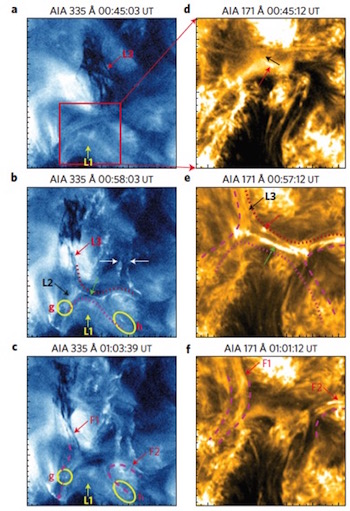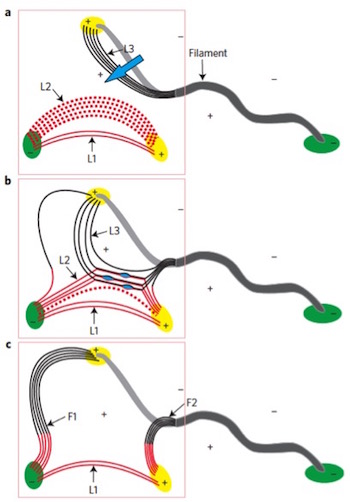Dr. Leping Li, Associate Professor at National Astronomical Observatories of Chinese Academy of Sciences (NAOC), leads an international research team including Prof. Jun Zhang and Dr. Huadong Chen at NAOC, Prof. Hardi Peter, Dr. Lijia Guo and Dr. Feng Chen at Max-Planck Institute for Solar System Research (MPS), and Prof. Eric Priest and Prof. Duncan Mackay at University of St Andrews, to study the magnetic reconnection. Recently, they made significant progress on magnetic reconnection studies. For the first time, they observationally analyze the fine structures and evolution of the magnetic reconnection process between a solar filament and its nearby coronal loops. The work has been published online on Nature Physics on May 9, 2016 [Nature Physics, 2016, DOI: 10.1038/NPHYS3768].
Magnetic reconnection, the reconfiguration of the magnetic field topology, shows a process of convergence, disconnection and reconnection of two sets of magnetic field lines with opposite polarities. It plays an essential role in rapid release of magnetic energy, which is converted to other energies (e.g. thermal and kinetic), in magnetized plasma systems (such as solar and stellar coronae, planetary magnetospheres, magnetars, accretion disks and laboratory plasmas) all over the universe. In astrophysics, it is usually employed to explain lots of astrophysical phenomena, such as solar flares, filament eruptions and γ-ray bursts. However, it is difficult to observe the magnetic reconnection process directly.
By analyzing the observations of the Solar Dynamics Observatory (SDO) and the Solar TErrestrial RElations Observatory (STEREO), Li et al. (2016) find that X-type structures form when the erupting filament encounters the coronal loops. At the interface, more than ten bright current sheets form, with mean length of ~26,000 km, mean width of ~900 km, and maximum temperature of more than 7 MK. Many plasmoids appear in these current sheets and propagate bi-directionally. The current sheets gradually disperse and disappear, lasting for more than ten minutes. The filament disconnects from the current sheets, and then reconnects to the coronal loops. At last, new filaments form.
This evolution indicates successive magnetic reconnection process, which is predicted by theory but rarely identified in observations with such clarity. The results confirm the three-dimensional magnetic reconnection theory, and further have implications for the release of magnetic energy and the evolution of dissipation regions for magnetic reconnection in all magnetized plasma systems.

Figure 1. SDO/AIA 335Å and 171 Å images before (a and d), during (b and e) and after (c and f) the magnetic reconnection between the filament and the coronal loops.

Figure 2. Schematic diagrams before (a), during (b) and after (c) the magnetic reconnection between the filament and the coronal loops.

Address: 20A Datun Road, Chaoyang District, Beijing, China code: 100012
Tel: 010-64888708 E-mail: naoc@nao.cas.cn

